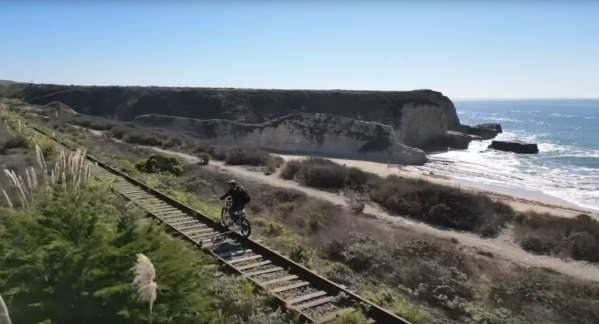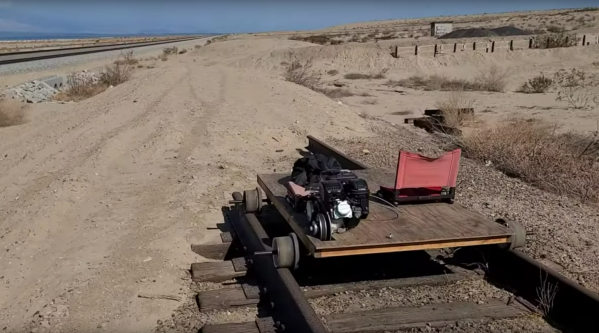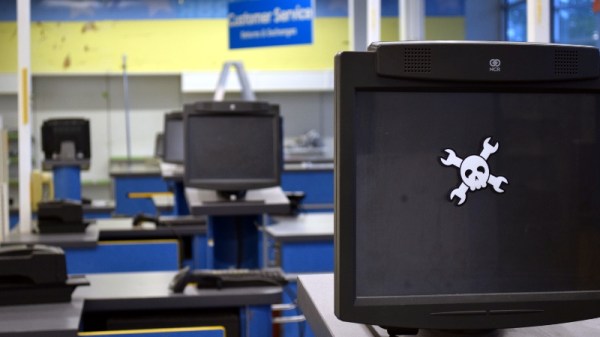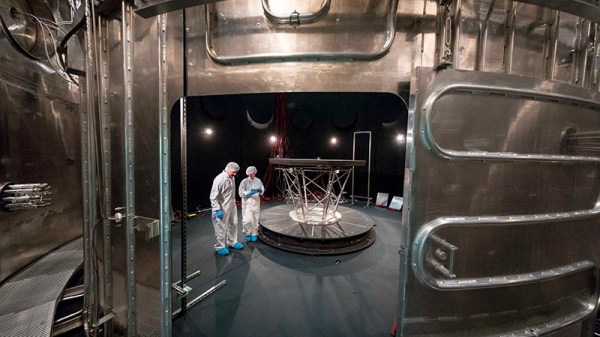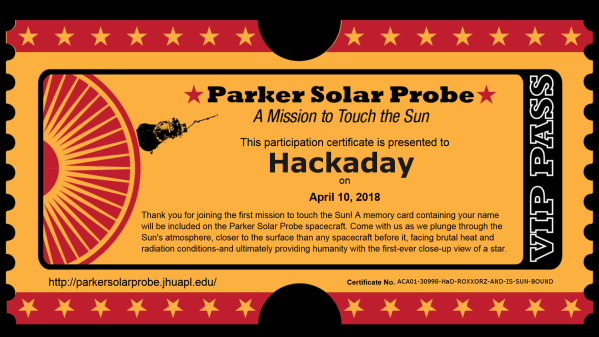As most developed countries around the world continue to modernize their transportation infrastructure with passenger rail, countries in North America have been abandoning railroads for over a century now, assuming that just one more lane will finally solve their traffic problems. Essentially the only upside to the abandonment of railroads has been that it’s possible to build some unique vehicles to explore these tracks and the beautiful yet desolate areas they reach, and [Cam Engineering] is using an ebike to do that along the coast of central California.
exploration14 Articles
Cart Cruises Abandoned California Rail
Southern California is known for its nearly perfect year-round climate, excellent surf, and extremely high cost of living, but once you get away from the coast things are radically different. Rural California has huge tracts of land run by the Bureau of Land Management (BLM), which is publicly accessible to anyone willing to venture into the deserts. There’s not much in the way of infrastructure out there, but [Ryan] does have a unique way of traveling through it using abandoned railroad lines and this custom rail cart.
The frame of this cart is simple enough, it’s little more than 2×3 framing with a plywood deck. Some extra support is added for the motor mount and for the seating location. It uses slightly longer go-kart axles to accommodate the width of the railroad, and a small six horsepower gas engine with a single gear to power the rear axle. There are no brakes other than the riders’ shoes, and while this all seems straightforward enough the real hack here is [Ryan]’s custom wheels. He found that steel or cast wheels were not particularly comfortable on long journeys so after a few attempts he has come up with a home-built polyurethane wheel which is cast in a mold around a steel go-cart wheel and then trimmed on a lathe.
For pure exploration, there’s almost no better place to go than the American west thanks to all the public BLM land available. In this cart, you can explore long distances using an extremely low-cost method of transportation. We’ve added another video of [Ryan] exploring this area below the break to show the cart being used, too, but if you’d like a more multipurpose vehicle to use on abandoned rail near you, take a look at this bicycle which is converted to operate on the railroad.
Interplanetary Whack-A-Mole: NASA’s High-Stakes Rescue Plan For InSight Lander’s Science Mission
People rightly marvel at modern surgical techniques that let surgeons leverage the power of robotics to repair the smallest structures in the human body through wounds that can be closed with a couple of stitches. Such techniques can even be applied remotely, linking surgeon and robot through a telesurgery link. It can be risky, but it’s often a patient’s only option.
NASA has arrived at a similar inflection point, except that their patient is the Mars InSight lander, and the surgical suite is currently about 58 million kilometers away. The lander’s self-digging “mole” probe needs a little help getting started, so they’re planning a high-stakes rescue attempt that would make the most seasoned telesurgeon blanch: they want to use the lander’s robotic arm to press down on the mole to help it get back on track.
Life At JPL Hack Chat
Join us on Wednesday, August 21st at noon Pacific for the Life at JPL Hack Chat with Arko!
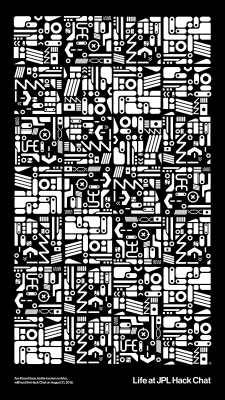 There’s a reason why people use “rocket science” as a metaphor for things that are hard to do. Getting stuff from here to there when there is a billion miles away and across a hostile environment of freezing cold, searing heat, and pelting radiation isn’t something that’s easily accomplished. It takes a dedicated team of scientists and engineers working on machines that can reach out into the vastness of space and work flawlessly the whole time, and as much practice and testing as an Earth-based simulation can provide.
There’s a reason why people use “rocket science” as a metaphor for things that are hard to do. Getting stuff from here to there when there is a billion miles away and across a hostile environment of freezing cold, searing heat, and pelting radiation isn’t something that’s easily accomplished. It takes a dedicated team of scientists and engineers working on machines that can reach out into the vastness of space and work flawlessly the whole time, and as much practice and testing as an Earth-based simulation can provide.
Arko, also known as Ara Kourchians, is a Robotics Electrical Engineer at the Jet Propulsion Laboratory, one of NASA’s research and development centers. Nestled at the outskirts of Pasadena against the flanks of the San Gabriel Mountains, JPL is the birthplace of the nation’s first satellite as well as the first successful interplanetary probe. They build the robots that explore the solar system and beyond for us; Arko gets to work on those space robots every day, and that might just be the coolest job in the world.
Join us on the Hack Chat to get your chance to ask all those burning questions you have about working at JPL. What’s it like to build hardware that will leave this world and travel to another? Get the inside story on how NASA designs and tests systems for space travel. And perhaps get a glimpse at what being a rocket scientist is all about.
 Our Hack Chats are live community events in the Hackaday.io Hack Chat group messaging. This week we’ll be sitting down on Wednesday, August 21 at 12:00 PM Pacific time. If time zones have got you down, we have a handy time zone converter.
Our Hack Chats are live community events in the Hackaday.io Hack Chat group messaging. This week we’ll be sitting down on Wednesday, August 21 at 12:00 PM Pacific time. If time zones have got you down, we have a handy time zone converter.
Click that speech bubble to the right, and you’ll be taken directly to the Hack Chat group on Hackaday.io. You don’t have to wait until Wednesday; join whenever you want and you can see what the community is talking about.
Exploring An Abandoned Toys “R” Us
If someone asked me to make a list of things I didn’t expect to ever hear again, the question “Do you want to go to a Toys “R” Us?” would be pretty near the top spot. After all of their stores (at least in the United States) closed at the end of June 2018, the House of Geoffrey seemed destined to join Radio Shack as being little more than a memory for those past a certain age. A relic from the days when people had to leave their house to purchase goods.
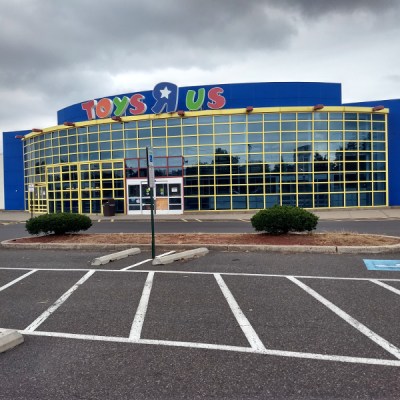 But much to my surprise, a friend of mine recently invited me to join him on a trip to the now defunct toy store. His wife’s company purchased one of the buildings for its ideal location near a main highway, and before the scrappers came through to clean everything out, he thought I might like a chance to see what was left. Apparently his wife reported there was still “Computers and stuff” still in the building, and as I’m the member of our friend group who gets called in when tangles of wires and sufficiently blinking LEDs are involved, he thought I’d want to check it out. He wasn’t wrong.
But much to my surprise, a friend of mine recently invited me to join him on a trip to the now defunct toy store. His wife’s company purchased one of the buildings for its ideal location near a main highway, and before the scrappers came through to clean everything out, he thought I might like a chance to see what was left. Apparently his wife reported there was still “Computers and stuff” still in the building, and as I’m the member of our friend group who gets called in when tangles of wires and sufficiently blinking LEDs are involved, he thought I’d want to check it out. He wasn’t wrong.
Readers may recall that Toys “R” Us, like Radio Shack before it, had a massive liquidation sale in the final months of operations. After the inventory was taken care of, there was an auction where the store’s furnishings and equipment were up for grabs. I was told that this location was no different, and yet a good deal of material remained. In some cases there were no bidders, and in others, the people who won the auction never came back to pick the stuff up.
So on a rainy Sunday evening in September, armed with flashlight, camera, and curiosity, I entered a Toys “R” Us for last time in my life. I found not only a stark example of what the changing times have done to retail in general, but a very surprising look at what get’s left behind when the money runs out and the employees simply give up.
Before Sending A Probe To The Sun, Make Sure It Can Take The Heat
This past weekend, NASA’s Parker Solar Probe took off for a journey to study our local star. While its mission is well covered by science literate media sources, the equally interesting behind-the-scenes information is a little harder to come by. For that, we have Science News who gave us a look at some of the work that went into testing the probe.
NASA has built and tested space probes before, but none of them were destined to get as close to the sun as Parker will, creating new challenges for testing the probe. The lead engineer for the heat shield, Elizabeth Congdon, was quoted in the article: “Getting things hot on Earth is easier than you would think it is, getting things hot on Earth in vacuum is difficult.” The team used everything from a concentrated solar facility to hacking IMAX movie projector lenses.
The extreme heat also posed indirect problems elsewhere on the probe. A rocket launch is not a gentle affair, any cargo has to tolerate a great deal of shock and vibration. A typical solution for keeping fasteners in place is to glue them down with an epoxy, but they’d melt where Parker is going so something else had to be done. It’s not all high technology and exotic materials, though, as when the goal was to verify that the heat shield was strong enough to withstand up to 20G of acceleration expected during launch, the test team simulated extra weight by stacking paper on top of it.
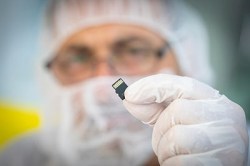 All that testing should ensure Parker can perform its mission and tell us a lot of interesting things about our sun. And if you got in on the publicity campaign earlier this year, your name is along for the ride.
All that testing should ensure Parker can perform its mission and tell us a lot of interesting things about our sun. And if you got in on the publicity campaign earlier this year, your name is along for the ride.
Not enough space probe action for the day? We’ve also recently featured how creative hacking gave the exoplanet hunter Kepler a second lease on life.
Get Your Name On The Hottest List In The Solar System
How often does NASA name a spacecraft after a living person? How often do you get to launch your name into a star? How often does NASA send probes to explore the sun? If your answer to all these questions is NEVER, then you win the honor of adding your name to an SD card bound for the center of our solar system. We’re already on the list with [William Shatner] so we’ll see you there. Submissions for the hot list aboard the Parker Solar Probe close on April 27th, 2018 and it launches in May.
The Parker Solar probe honors living astrophysicist [Eugene Parker] who theorized a great deal about how the sun, and other stars, emit energy. His work has rightly earned him the honor of seeing his name on a sun-bound probe. We even owe the term, “solar wind” to [Parker].
To draw more attention, you can have a few bits aboard this probe dedicated to you or someone you care about by adding your name to their list. Or you can send the name of your greatest enemy into the hottest furnace for millions of miles. Your call.
Even though our sun is the most prominent heavenly body, NASA hasn’t sent a probe to explore it before. They are good about sharing their models and they really know how to write standards for workmanship.
Continue reading “Get Your Name On The Hottest List In The Solar System”

